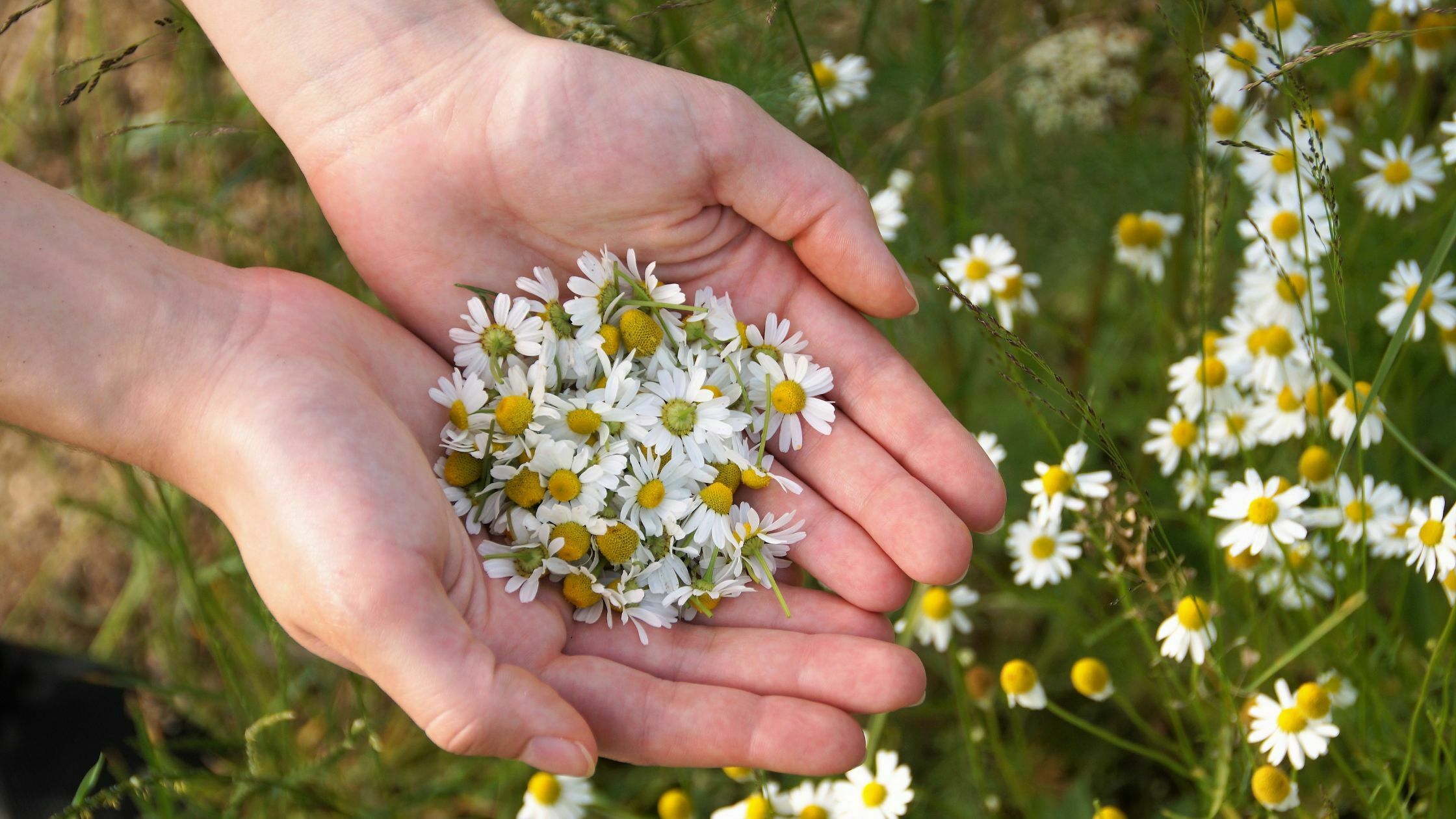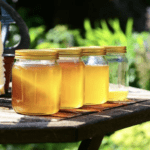Do you enjoy chamomile tea? How about growing it yourself for all your chamomile needs? Chamomile is widely popular and ready to grow in your own garden. The reason why today, we’ll be sharing with you everything you need to know about how to harvest chamomile the right way.
Chamomile is a flowering herb in the Asteraceae plant family, grown primarily for medicinal uses and herbal tea. Chamomile constitutes a beautiful ornamental plant that offers a pleasing aroma.
If you have the chance to grow chamomile, then harvesting is in your future. Though it may sound intimidating when you are a beginner, you have nothing to worry about since the process is fairly simple. Keep reading, take notes and learn everything about how to harvest chamomile.
How to Harvest Chamomile
- The first step in harvesting chamomile is to gently pinch the plant’s stem, just below the flower head, with your left (or non-dominant) hand.
- Place your forefinger and middle finger under the head of the chamomile flower, between the flower head and your other pinched fingers.
- Alternatively, you can snip the flower heads off each stem with a pair of scissors. Try to get as little stem as possible.
Recommended Product: Multi-function Kitchen Scissors
[amazon box=”B07K72PHLS” class=”lp-product-list” template=”vertical” image_size=”large” title=” ” image_alt=”alttexthere” description=”none” price=”none” button_text=”Check Latest Price” ]
Made of steel, these Heavy Duty Kitchen Scissors are forged from top premium grade stainless steel that is rust-resistant and corrosion-resistant, with ultra-sharp blades.
In addition to being widely used in the kitchen, it has more uses, which can be used as a nuts cracker, bottle opener, scales scraper, with micro-serrated edge for slip-proof cutting, comfortable, easy-grip handles—great grip for both right and left-handed.
These kitchen scissors ensure non-slip cutting in various tasks, saving effort while avoiding accidental injury whenever you are using them.
Features:
- Stainless Steel
- Multi-function
- Easy-grip handles
What are the two common varieties of chamomile you can plant in your garden?
German chamomile: German chamomile (Matricaria recutita) is an annual plant known for its potent essential oils. German chamomile can reach a height of two feet, and its daisy-like flowers bloom in early summer. You can make chamomile tea with German chamomile, but the tea tastes bitter.
Roman chamomile: Roman chamomile (Chamaemelum Nobile) is a perennial plant you can grow as a lawn or ground cover. Like German chamomile, it also features daisy-like flowers that bloom from early summer through the first autumn frost. Its low height (three to six inches tall) makes it the perfect option for edging walkways and filling space between taller plants.
Roman chamomile has a slightly sweet taste, perfect for chamomile tea.
Recommended Product: Roman Chamomile Seeds for Planting
[amazon box=”B07VWXVFH6″ class=”lp-product-list” template=”vertical” image_size=”large” title=” ” image_alt=”alttexthere” description=”none” price=”none” button_text=”Check Latest Price” ]
A full-color packet of Roman Chamomile seeds, A perennial low-growing ground cover that will spread via rhizomes. Daisy-like blossoms are used for tea and medicinal purposes. Tolerates light foot traffic—minimum of 200 mg per packet.
Chamomile is super easy to grow and has many benefits. The dried flowers/leaves make a popular herbal tea that is very soothing before bedtime.
Sow Right Seeds has taken the Safe Seed Pledge and sells only Non-GMO heirloom seeds safe for you and your family.
Features:
- Non-GMO
- Instructions included
How to grow chamomile?
- Soil type: Chamomile thrives in well-drained, sandy soils. Work a two-inch layer of compost into your garden bed to improve drainage and enrich the soil with nutrients.
- Light: Full sun is ideal for chamomile, but partial shade prevents the plants from drying out in sweltering climates.
- Watering: Ensure the soil around your chamomile plants is moist but never sopping wet. Chamomile generally requires an inch of water every week throughout the growing season.
- Starting seeds indoors: Start chamomile seeds indoors for four to six weeks before transplanting outside. Fill small pots or a seed tray with seed-starting mix. Place your container in a warm area with direct sunlight or under a grow light, and make sure to keep the soil moist. Once the seedlings have grown two true leaves, you can transplant them outdoors.
- Companion planting: Chamomile is a wonderful companion plant to grow in a vegetable garden, as it benefits brassicas, onions, cucumbers, and other herbs.
Which part of chamomile is used for tea?
Chamomile tea is brewed using just the flower heads of the plant. Chamomile plants have strongly scented foliage and chamomile blossoms that feature white petals and yellow centers.
What month do you harvest chamomile?
You’ll know chamomile is ready to harvest once its flower petals begin to droop backward. This typically occurs in late summer or early autumn, about three to four months after planting.
Don’t harvest chamomile right after a rain when the flowers are wet; wait at least two days to give them time to dry.
Can you use the leaves of chamomile?
You can! Chamomile leaves and flowers are both perfectly safe to eat; there are a couple of things you should keep in mind, however. Be sure the herb hasn’t been sprayed with pesticides or herbicides. Use chamomile with care if you’re allergic to ragweed, as chamomile may trigger allergic reactions in some individuals.
Does chamomile grow back after cutting?
If the production of flowers begins to slow down and your plants grow spindly, it’s time to prune. You can cut the mass back, leaving about 4″-5″ growth. This will stimulate new growth and the second wave of blooms.
How long does chamomile take to grow?
Chamomile is a fast grower. You will see the first shoots in late spring, and within a few weeks, they will be grown and ready to harvest.
How to dry and store chamomile?
Dry the chamomile flowers in a loose paper bag with air circulation for one to two weeks. You’ll know they are scorched when you rub them between your fingers, and they crumble into tiny pieces.
Store the dried flowers in an airtight container, like a glass mason jar or a tea tin, and place them in a cool, dark location.
Recommended Product: Ball Regular Mouth Mason
[amazon box=”B01N6QBJG0″ class=”lp-product-list” template=”vertical” image_size=”large” title=” ” image_alt=”alttexthere” description=”none” price=”none” button_text=”Check Latest Price” ]
Regular Mouth glass preserving Mason Jar with Lids; ideal for sliced fruits and vegetables, pickles, tomato-based juices, and sauces.
New and Improved Sure Tight Lids help keep canned food sealed for up to 18-Months.
Regular Mouth jars work best with pourable foods such as jams and jellies, salsas, pie fillings, or chopped fruits and vegetables.
Features:
- 16 Fluid Ounces
- BPA-Free
You can alternatively use a dehydrator. Spread the flowers on the dehydrator sheets and set them as low as possible. After about 2 hours, start checking every hour.
When a flower head crumbles easily between your fingers, they’re done. Store in an airtight jar in a cool dark place.
Recommended Product: COSORI Premium Food Dehydrator Machine
[amazon box=”B07PY5M579″ class=”lp-product-list” template=”vertical” image_size=”large” title=” ” image_alt=”alttexthere” description=”none” price=”none” button_text=”Check Latest Price” ]
Made with food-grade stainless steel and a glass front door, this dehydrator is perfect for making healthy beef jerkies, snacks, fruit leathers, dog treats, and bread crumbs, and for preserving herbs, flowers, and much more.
Use the digital control panel to set the timer in 30-minute increments for up to 48 hours. Make average-sized batches of dried foods with accurate temperatures.
The six trays are dishwasher-safe, and tray liners can be washed on the top rack of your dishwasher if you remove them before the drying cycle.
Features:
- 100% BPA-FREE Tray liners
- Auto shut off
- Dishwasher-safe
Additional Tips on How to Harvest Chamomile
- Chamomile flowers have a yellow cone-like center set amid delicate white daisy-like petals. The flowers start with the petals folded over the center. The petals open outwards, and the flowers are ready to be harvested when the petals start to fold back slightly from the center.
- To harvest chamomile, pick the flowers after the morning dew has dried off.
- Once chamomile flowers start blooming, they will keep flowering for several weeks to about two months. They tend to die out as the plants dry up when the heat of summer hits.
- You can probably harvest twice a week while they’re flowering, and each plant produces lots of little flowers.



